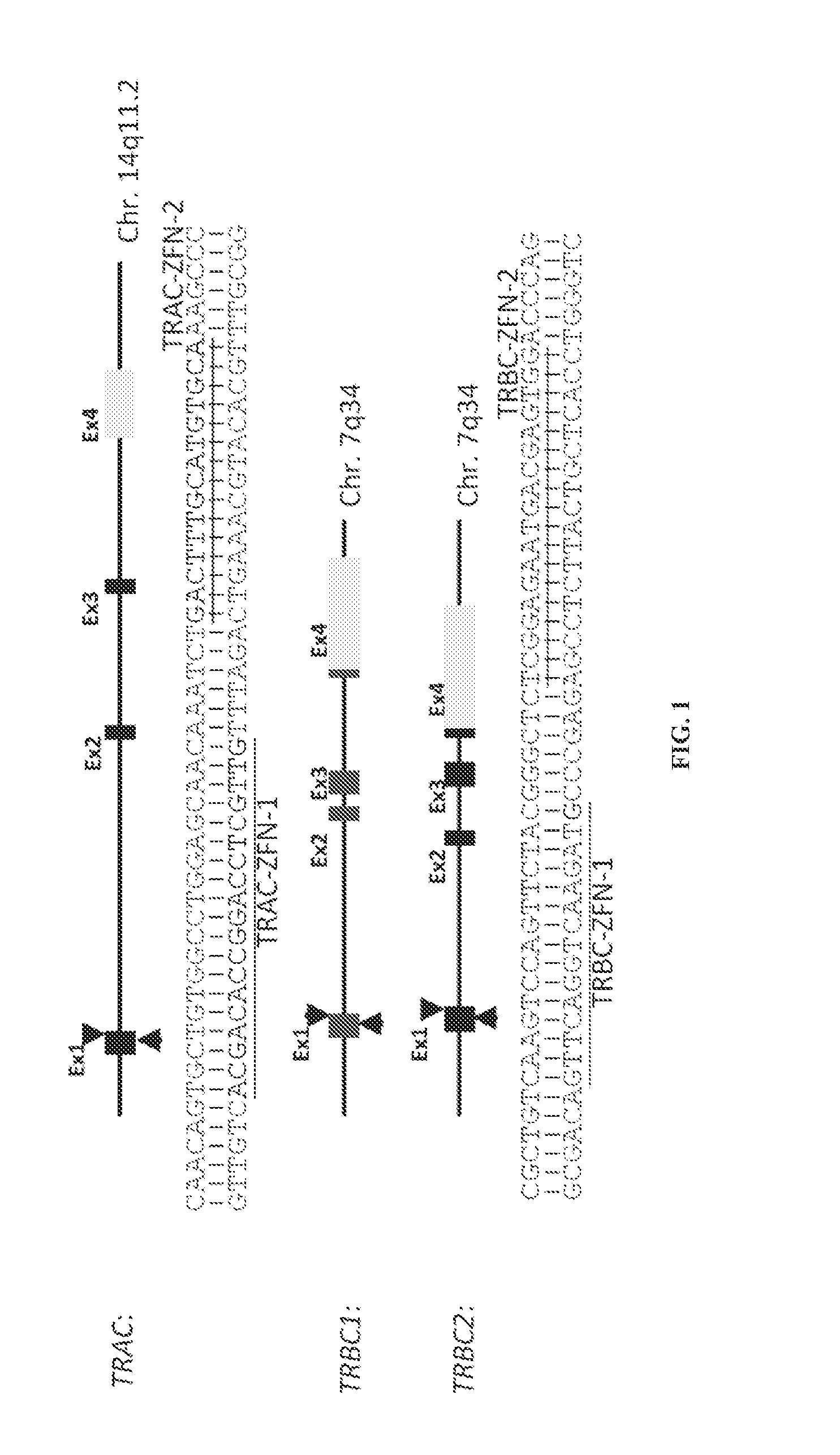Car+ t cells genetically modified to eliminate expression of t-cell receptor and/or HLA
a technology of t-cell receptor and hla, which is applied in the field of immunology, can solve the problems of relapse remaining a major cause of death, and is limited by the time and expense of manufacturing patient-specific t-cell products, and achieve the effect of removing the expression of t-cell receptor
- Summary
- Abstract
- Description
- Claims
- Application Information
AI Technical Summary
Benefits of technology
Problems solved by technology
Method used
Image
Examples
example 1
Exemplary Materials and Methods
[0162]Human Subjects
[0163]Peripheral blood mononuclear cells (PBMC) were obtained from healthy adult volunteer donors who had provided informed consent from Gulf Coast Regional Center (Houston, Tex.) in accordance with the Declaration of Helsinki and participated in research approved by MD Anderson Cancer Center (MDACC).
[0164]ZFNs Targeting Constant Regions of α and β TCR
[0165]ZFNs containing five or six fingers were assembled from an established archive of pre-validated 2-finger and 1-finger modules as described (Doyon et al., 2008; Isalan et al., 2001). ZFN pairs were designed to bind either a sequence within exon 1 of the TCR α constant region (TRAC: NG—001332.2; ZFNs designated as TRAC-ZFN-1 and TRAC-ZFN-2) or a consensus sequence common to exon 1 of both TCR β constant regions 1 and 2 (TRBC1 and TRBC2: NG—001333.2; ZFNs designated as TRBC-ZFN-1 and TRBC-ZFN-2). Genes encoding the ZFNs were assembled using PCR-based methodology and cloned into a DN...
example 2
Disruption of the αβ TCR-CD3 Complex on T Cells Using ZFNS
[0184]Two ZFN pairs targeting the constant regions of TCR α (TRAC-ZFN-1 and TRAC-ZFN-2) or TCR β (TRBC-ZFN-1 and TRBC-ZFN-2) (FIG. 1) were developed and tested in primary human T cells propagated ex vivo for six days on OKT3-loaded aAPC (clone #4). Since transient expression of ZFNs is sufficient to mediate gene knockout, the inventors developed a “hit-and-run” delivery strategy to transiently express the ZFNs utilizing electro-transfer of in vitro transcribed mRNA species coding for the ZFN pairs (FIG. 2a). To measure TCR expression the inventors used a mAb specific for CD3ε, which is only present on the cell surface when TCRαβ is expressed. Nine days after electro-transfer, flow cytometric analysis revealed that ZFN pairs targeting TRAC or TRBC eliminated CD3ε expression on primary T cells at levels reaching 19.4% and 5.2%, respectively. The efficiency of TCR knockout correlated with the amount of electro-transferred mRNA (...
example 3
Enrichment of TCR αβ Negative T Cells
[0186]For future clinical applications, rapid and robust methods for isolating sources of TCR disrupted population will be needed. To begin to address this issue, the inventors enriched the TCR / CD3neg population by negative selection using clinically-approved paramagnetic beads and a depletion column. With a single depletion step, the CD3εneg population was enhanced to over 93% (FIG. 3a). A CD3εneg population could not be enriched from untransfected control cells. Back-to-back depletion steps resulted in >99% enrichment without skewing the CD4+ or CD8+ T cell subsets (FIG. 9). An analysis of TCR Vβ repertoire in enriched TCRneg T cells via flow cytometry validated the elimination of TCRβ expression from the cell surface (FIG. 3b).
PUM
| Property | Measurement | Unit |
|---|---|---|
| fluorescence-activated cell | aaaaa | aaaaa |
| molecular weight | aaaaa | aaaaa |
| structures | aaaaa | aaaaa |
Abstract
Description
Claims
Application Information
 Login to View More
Login to View More - R&D
- Intellectual Property
- Life Sciences
- Materials
- Tech Scout
- Unparalleled Data Quality
- Higher Quality Content
- 60% Fewer Hallucinations
Browse by: Latest US Patents, China's latest patents, Technical Efficacy Thesaurus, Application Domain, Technology Topic, Popular Technical Reports.
© 2025 PatSnap. All rights reserved.Legal|Privacy policy|Modern Slavery Act Transparency Statement|Sitemap|About US| Contact US: help@patsnap.com



